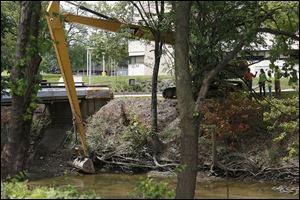
COMMENTARY
UT proud of new look, new life for Ottawa River
8/18/2013
Ecological restoration continues to the Ottawa River at the University of Toledo. It has worked to restore all 3,700 feet of the river that runs through campus.
Cross the bridge over the Ottawa River in the heart of the University of Toledo campus less than a decade ago, and you were more likely to see a discarded shopping cart than a smallmouth bass.
Take that same stroll today, and there’s no more societal debris littering the waterway, and what you see looks very much like the makings of a good fishing stream.
The short stretch of the Ottawa that makes a diagonal cut across the school’s main grounds has had an extreme makeover, habitat edition. Gone are the flotsam and jetsam that were so visually distasteful, and a good share of the invisible trash — industrial pollutants, sewage overflows and excess sediment — that have tainted the river for so long.
The campus waterway is undergoing the final phase of a restoration effort that began back in 2005 with the formation of a university president’s commission to address the many concerns associated with river.
“We had a river that, from a lot of people’s perception, was just dirty and ugly,” said Patrick Lawrence, a UT professor who heads the group that has been restoring the campus stretch of river.
“What they see now is something very different.”
The latest phase of the project called for the placement of logs, large rocks, and other materials in the waterway to bring back some of the character of its original path through campus. Helped by the removal of a dam further upstream, long, flat, shallow stretches are being replaced with minor bends and diversions in the flow that are intended to create a more natural combination of riffles and pools.
“Right now, the river is essentially uniform with very limited ripples or turbulence,” Lawrence said. “Adding these natural materials will also make for more diversity to the aquatic habitat, giving fish and other aquatic organisms more places for nesting, spawning, food, and shelter.”
Carson Prichard, a PhD candidate who started fishing the Ottawa above campus last fall, surprised many longtime river watchers when he caught steelhead in the river. Steelhead are a rainbow trout that spend the summers in Lake Erie and then as mature adults migrates up streams from the fall through the spring. They prefer cool, clean waters, and the Ottawa would have been unattractive and off-limits to steelhead.
Prichard, who taught an environmental class for non-science majors at UT last fall, said his students from this area had an image of Ottawa River that was based on its days as a polluted waterway, guarded by bright yellow signs warning of the dangers the water presented.
“It’s hard for me to believe that it was as bad as it has been described to me,” Prichard said. “It doesn’t look anything like that anymore.”
The local chapter of Partners for Clean Streams has been actively involved in the UT river restoration project since its inception, according to its executive director Kristina Patterson, who said a common vision has brought multiple parties to the river’s edge.
“As important as these stream restoration projects are ecologically, I really believe the bigger significance is in re-connecting people to a recovering river, so that the momentum for the restoration continues to groundswell,” Patterson said.
She stressed the link between the UT project and similar restoration efforts elsewhere along the waterway, at Camp Miakonda and in Ottawa Hills.
“These showcase a river teeming with life, a river on the rebound,” she said. “This trio of projects builds on a renewed excitement in dramatically improving the health of the Ottawa River, and by extension, the health of the community up and down its riverbanks.”
Patterson added that the stream restoration projects remove the barriers presented by pollution, debris, overgrowth of vegetation, and also some of the stigma associated with the waterway.
“Each project visually and physically re-connects people with the river,” she said. “By reconnecting people to a river ... and by showing people the potential in this river, then we get people to care. And if they care, they will act and if they act, they will change.”
Matt Horvat of TMACOG, another partner in the river projects, said he believes that dramatic improvement in access to the river is a major benefit of the clean-up work and restoration efforts. Paths to the waterway are now easily accessible.
“I think the perception of the river has certainly been changing,” Horvat said. “Anytime you give people access, you change their mentality and attitude towards something. Access is something that was certainly needed here.”
Lawrence said the project, which is funded with a $235,000 grant from the Ohio Environmental Protection Agency and a $151,000 grant from the U.S. Fish and Wildlife Service, will benefit the UT students, who will have an increasingly beneficial living science lab in the middle of campus.
“This was really an opportunity for the university to be engaged in the ongoing effort to improve the Ottawa River,” he said, “and to have the university take a role in the good stewardship of the river. As the students return, we’ll have a great opportunity to use the river more as an educational tool.”
Lawrence admits that the river still has “legacy concerns” from decades of pollution, but significant progress has been made toward making it “a natural functioning river again.”
The Beaverkill, the Manistee, or the Madison it is not, and never will be, but Prichard, a west Michigan native who has fished for steelhead in the rivers near his home, said he sees a healthier Ottawa River for fish in the future.
Contact Blade outdoors editor Matt Markey at: mmarkey@theblade.com or 419-724-6068.